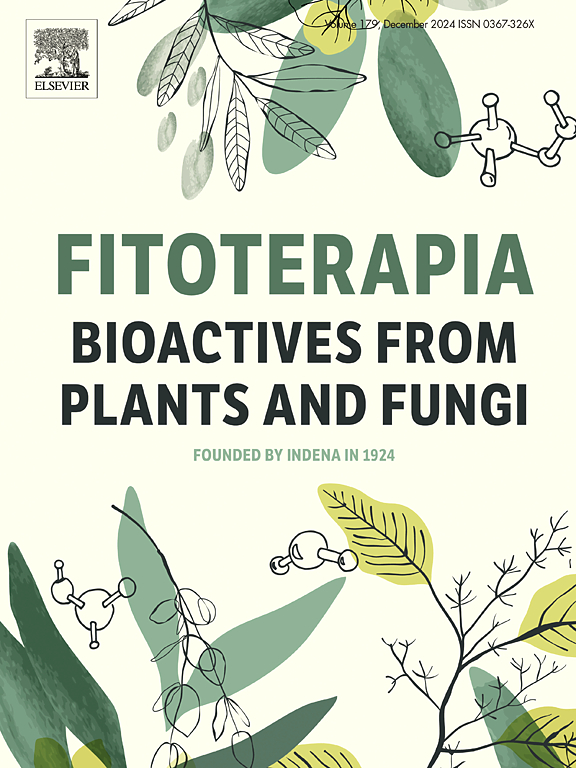Adding value to botanical resources: Metabolic network analysis along with high-resolution bioassays screening and UHPLC-qToF-high-resolution MS/MS profiling detail the pharmacological potential of underexplored Latin-American plants
IF 2.6
3区 医学
Q3 CHEMISTRY, MEDICINAL
引用次数: 0
Abstract
Healthcare services are challenged by an increased incidence of diseases and a decline in new drugs being brought to market. Thus, there is renewed interest in drug discovery from plants. This paper focused on enhancing the value of a small but diverse botanical resource of 45 Latin-American plant species, mostly from Mexican origin, through untargeted metabolomics, metabolic network analysis and parallel-in-vitro-bioactivity screening. The plant-extract collection was tested for inhibitory activity of human neutrophil elastase (HNE), α-glucosidase and PTP-1B as well as reviewing in detail antifungal and CB2-agonist activities previously reported for this collection. Through these approaches it was found that only 30 % of plants mentioned in traditional medicine to treat diabetes, had greater than 60 % inhibitory activity against PTP-1B or α-glucosidase and this could be part of their modes of action, while six plant species previously undescribed for antidiabetic use could inhibit these enzymes, with three of these plant species being ornamentals (Cosmos bipinnatus, Cuphea ignea and Clarkia amoena). Biochromatograms from active extracts show that the bioactivity is due to specific fractions/compounds. The results, indicate that parallel-in-vitro-bioactivity screening of plants is a valuable approach that could lead to the expansion of the natural-product chemical space for new therapeutics, even if no previous evidence of their use in traditional medicine exists. Results for HNE, CB2-agonist and antifungal assays were similar. This study delivers a valuable UHPLC-qToF-HRMS/MS dataset along with bioactivity screens that can serve the natural-products community for future endeavors in exploring the valuable chemical space of Latin-American plants.

增加植物资源的价值:代谢网络分析以及高分辨率生物测定筛选和uhplc - qtof高分辨率MS/MS分析详细介绍了未开发的拉丁美洲植物的药理潜力。
由于疾病发病率增加和投放市场的新药减少,保健服务受到挑战。因此,人们对从植物中发现药物重新产生了兴趣。本文旨在通过非靶向代谢组学、代谢网络分析和体外平行生物活性筛选等方法,提高45种拉丁美洲植物资源(主要来自墨西哥)的价值。我们测试了这些植物提取物对人中性粒细胞弹性酶(HNE)、α-葡萄糖苷酶和PTP-1B的抑制活性,并详细回顾了之前报道的这些植物提取物的抗真菌和cb2激动剂活性。通过这些方法发现,传统医学中治疗糖尿病的植物中只有30% %对PTP-1B或α-葡萄糖苷酶的抑制活性大于60% %,这可能是其作用模式的一部分,而以前未描述的抗糖尿病植物中有6种可以抑制这些酶,其中3种是观赏植物(Cosmos bipinnatus, Cuphea ignea和Clarkia amoena)。活性提取物的生物色谱图表明,其生物活性是由特定的组分/化合物引起的。研究结果表明,植物的体外平行生物活性筛选是一种有价值的方法,可以扩大天然产物化学领域的新疗法,即使之前没有证据表明它们在传统医学中使用。HNE、cb2激动剂和抗真菌试验结果相似。该研究提供了一个有价值的UHPLC-qToF-HRMS/MS数据集以及生物活性筛选,可以为未来探索拉丁美洲植物的宝贵化学空间提供服务。
本文章由计算机程序翻译,如有差异,请以英文原文为准。
求助全文
约1分钟内获得全文
求助全文
来源期刊

Fitoterapia
医学-药学
CiteScore
5.80
自引率
2.90%
发文量
198
审稿时长
1.5 months
期刊介绍:
Fitoterapia is a Journal dedicated to medicinal plants and to bioactive natural products of plant origin. It publishes original contributions in seven major areas:
1. Characterization of active ingredients of medicinal plants
2. Development of standardization method for bioactive plant extracts and natural products
3. Identification of bioactivity in plant extracts
4. Identification of targets and mechanism of activity of plant extracts
5. Production and genomic characterization of medicinal plants biomass
6. Chemistry and biochemistry of bioactive natural products of plant origin
7. Critical reviews of the historical, clinical and legal status of medicinal plants, and accounts on topical issues.
 求助内容:
求助内容: 应助结果提醒方式:
应助结果提醒方式:


